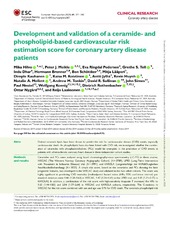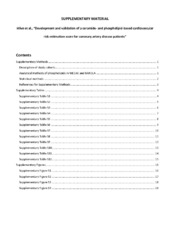| dc.contributor.author | Hilvo, M | en_US |
| dc.contributor.author | Meikle, PJ | en_US |
| dc.contributor.author | Pedersen, ER | en_US |
| dc.contributor.author | Tell, Grethe S. | en_US |
| dc.contributor.author | Dhar, Indu | en_US |
| dc.contributor.author | Brenner, H | en_US |
| dc.contributor.author | Schöttker, B | en_US |
| dc.contributor.author | Lääperi, M | en_US |
| dc.contributor.author | Kauhanen, D | en_US |
| dc.contributor.author | Koistinen, KM | en_US |
| dc.contributor.author | Jylhä, A | en_US |
| dc.contributor.author | Huynh, K | en_US |
| dc.contributor.author | Mellett, NA | en_US |
| dc.contributor.author | Tonkin, AM | en_US |
| dc.contributor.author | Sullivan, DR | en_US |
| dc.contributor.author | Simes, J | en_US |
| dc.contributor.author | Nestel, P | en_US |
| dc.contributor.author | Koenig, W | en_US |
| dc.contributor.author | Rothenbacher, D | en_US |
| dc.contributor.author | Nygård, Ottar | en_US |
| dc.contributor.author | Laaksonen, R | en_US |
| dc.date.accessioned | 2020-06-26T07:55:05Z | |
| dc.date.available | 2020-06-26T07:55:05Z | |
| dc.date.issued | 2020 | |
| dc.Published | Hilvo, Meikle, Pedersen, Tell GST, Dhar I, Brenner H, et al. Development and validation of a ceramide- and phospholipid-based cardiovascular risk estimation score for coronary artery disease patients.. Journal of Heart Failure. 2020;41:371-380 | eng |
| dc.identifier.issn | 1070-3837 | |
| dc.identifier.uri | https://hdl.handle.net/1956/23026 | |
| dc.description.abstract | Aims: Distinct ceramide lipids have been shown to predict the risk for cardiovascular disease (CVD) events, especially cardiovascular death. As phospholipids have also been linked with CVD risk, we investigated whether the combination of ceramides with phosphatidylcholines (PCs) would be synergistic in the prediction of CVD events in patients with atherosclerotic coronary heart disease in three independent cohort studies. Methods and results: Ceramides and PCs were analysed using liquid chromatography–mass spectrometry (LC-MS) in three studies: WECAC (The Western Norway Coronary Angiography Cohort) (N = 3789), LIPID (Long-Term Intervention with Pravastatin in Ischaemic Disease) trial (N = 5991), and KAROLA (Langzeiterfolge der KARdiOLogischen Anschlussheilbehandlung) (N = 1023). A simple risk score, based on the ceramides and PCs showing the best prognostic features, was developed in the WECAC study and validated in the two other cohorts. This score was highly significant in predicting CVD mortality [multiadjusted hazard ratios (HRs; 95% confidence interval) per standard deviation were 1.44 (1.28–1.63) in WECAC, 1.47 (1.34–1.61) in the LIPID trial, and 1.69 (1.31–2.17) in KAROLA]. In addition, a combination of the risk score with high-sensitivity troponin T increased the HRs to 1.63 (1.44–1.85) and 2.04 (1.57–2.64) in WECAC and KAROLA cohorts, respectively. The C-statistics in WECAC for the risk score combined with sex and age was 0.76 for CVD death. The ceramide-phospholipid risk score showed comparable and synergistic predictive performance with previously published CVD risk models for secondary prevention. Conclusion: A simple ceramide- and phospholipid-based risk score can efficiently predict residual CVD event risk in patients with coronary artery disease. | en_US |
| dc.language.iso | eng | eng |
| dc.publisher | Oxford University Press | eng |
| dc.rights | Attribution-Non Commercial CC BY-NC | eng |
| dc.rights.uri | http://creativecommons.org/licenses/by-nc/4.0/ | eng |
| dc.title | Development and validation of a ceramide- and phospholipid-based cardiovascular risk estimation score for coronary artery disease patients. | en_US |
| dc.type | Peer reviewed | |
| dc.type | Journal article | |
| dc.date.updated | 2020-01-28T09:15:02Z | |
| dc.description.version | publishedVersion | en_US |
| dc.rights.holder | Copyright 2019 The Authors | |
| dc.identifier.doi | https://doi.org/10.1093/eurheartj/ehz387 | |
| dc.identifier.cristin | 1772224 | |
| dc.source.journal | Journal of Heart Failure | |


